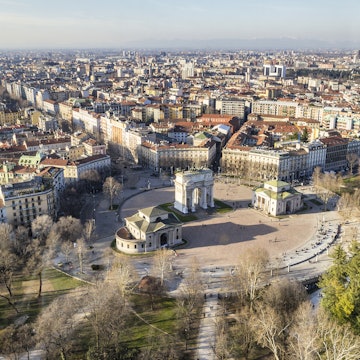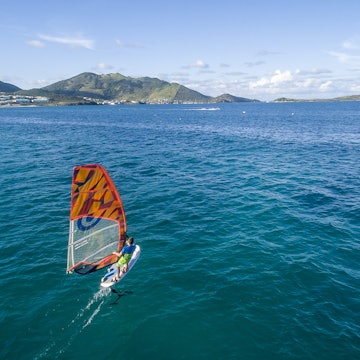

The island of Andros, the Bahamas. Troutnut/Shutterstock
It’s all about the heat come July, with the northern hemisphere’s sizzling summer temperatures adding an extra shine to some of the world’s most popular travel destinations. Europe is bathed in sunshine, bringing the Mediterranean beach scene to the forefront, while in the tropics dry season signals prime wildlife spotting opportunities. Colder regions also benefit from the heat, with Arctic areas at their most accessible. Finally, there are the summer festivals and celebrations that bring fun and adventure to many destinations around the world.
Plan your July vacation with this pick of our favorite places to go.

1. Zanzibar, Tanzania
Best for relaxing by the Indian Ocean
The spice island Unguja – known to most as Zanzibar – is a scent sensation. Stroll the maze-like alleys of old Stone Town on a warm evening, and you’ll catch whiffs of nutmeg, clove and cinnamon in the Darajani Market, frying seafood at stalls in Forodhani Gardens, and the aroma of black coffee in Jaws Corner, where older locals gather to watch TV and gossip. Zanzibar’s historic heart, with its crumbling palaces and heartrending slavery-era relics, is just one gem of this treasure-trove island, at its best in July, in the middle of the dry season. Board a dhow to snorkel off the west coast, watching for dolphins; sniff the leaves and buds of a spice plantation; and find your own patch of coral-sand perfection on one of the wonderful beaches.

2. Westfjords, Iceland
Best for a road trip under the midnight sun
Iceland’s far northwest is crowned the Westfjords, spectacular fjords, glacial valleys and sheer scarps ice-scoured over millennia. The completion of the Dýrafjörður Tunnel in 2020 made possible a new road trip: the Vestfjarðaleiðin (Westfjords Way), a 950km (590 mile) circular drive with branches reaching the wildest highlights, offering a peaceful alternative to the popular Ring Road. Get behind the wheel in high summer, when roads are clear and night never comes, and when breeding puffins and other seabirds throng the soaring seacliffs of Látrabjarg. Of course, you’ll want to park up to explore on foot, too to spot an Arctic fox among the orchid-specked wilds of Hornstrandir Nature Reserve, to join seals on the pink-sand beach of Rauðasandur, to soak in Drangsnes geothermal pool, to gawp at Drangajökull glacier and the seven tiers of Dynjandi Falls, and to meet the smiling, independent people of this long-isolated region.
Planning tip: The Vestfjarðaleiðin peels off from Rte 1, the main ring road, 111km (69 miles) north of Reykjavík, a little further from Keflavík International Airport. Allow at least a week to circuit the Westfjords.

3. Andros and Bimini, the Bahamas
Best for wildlife and few crowds
The Bahamas are almost the Caribbean – yet, crucially, not quite. True, this speckle of islands and cays between Cuba and Florida boasts serene waters and beautiful beaches. But summer here, though “rainy,” is less afflicted by the storms that often hit other islands. July brings calm, clear, warm seas, ideal for enjoying superb diving and snorkeling off tourist-light Andros; its east coast is protected by the world’s third-longest barrier reef. Hop across to Bimini for manta ray encounters (peaking in July, when sharks are less prevalent) and the chance to come face to smiling beak with an Atlantic spotted dolphin. Add mangroves, excellent fishing, thriving birdlife and white-powder beaches, but subtract crowds – Andros is even quieter and better value in July.

4. Northwest Territories, Canada
Best for wild rivers and Indigenous culture
This vast region of tundra and taiga is as empty as it is wild, with a population smaller than the tiniest Caribbean nation scattered across a land nearly as large as Mongolia. To discover the natural and cultural wonders of the Northwest Territories, take a river journey into its untamed heart, possible for just a few weeks from late June when temperatures are (relatively) balmy and days stretch forever. Canoe a stretch of Canada’s longest river, the Deh Cho (Mackenzie); raft the South Nahanni from thundering, 96m-high (315ft) Virginia Falls in the sky-piercing Mackenzie Mountains; or enjoy a gentle kayak on Great Slave Lake, North America’s deepest. En route, learn about the traditional culture of the Dene peoples who have adapted to this challenging environment over tens of millennia, and watch for caribou, Dall sheep, black bear, moose and wood bison – the continent’s largest land mammal.

5. Coral Coast, Western Australia
Best for rays, whale sharks and humpbacks
Stretching over 1000km (621 miles) between Cervantes and Exmouth, the Coral Coast of Western Australia encapsulates much of the country’s appeal in miniature, making this relatively little-touristed stretch ideal for a winter road trip through empty expanses. Here, you’ll discover dramatic rock formations – the Pinnacles, limestone needles punching through the sand near Cervantes – and russet Tumblagooda Sandstone gorges in Kalbarri National Park. You’ll experience surfing and subaquatic adventures along the world’s largest fringing reef – 300km (186 miles) of coral that’s home to some 500 fish species. And you’ll meet miraculous marine wildlife, like when whale sharks gather in their hundreds on Ningaloo Reef (March to July), along with manta rays – more numerous off Exmouth May to September – and humpbacks too.

6. Aarhus and Jutland, Denmark
Best for sunny days in a cultural and culinary hot spot
Denmark’s second city is buzzier than a beehive. Founded by Vikings some 13 centuries ago, today Aarhus is eminently contemporary, with its groundbreaking ARoS art museum, rejuvenated waterfront cultural center, Dokk1, and innovative Iceberg apartment blocks. Even the Moesgaard Museum, home of the 2000-year-old, bog-preserved Graubelle Man, offers a cutting-edge tour through the past. Come evening, the city reveals its true colors, with cafes, cocktail bars and clubs showcasing that quintessentially Danish blend of smiles and smarts. High summer brings a host of festivals celebrating flowers, jazz, Viking heritage and more, plus warm sun (nudging 20ºC/68ºF) for basking on sandy Baltic beaches: try Den Permanente near the center, silky-soft Bellevue just to the north, and the blissfully empty strands of eco island Samsø, just a short ferry ride away.

7. Via Dinarica, Eastern Europe and Western Balkans
Best for a long-distance hike
Parts of the former Yugoslavia have developed rapidly since its breakup: Croatia’s much-vaunted coast, for example, is bustling in summer. Yet in hamlets speckling the remote higher reaches of the Dinaric Alps, time seems to have stood still. The best way to immerse yourself in traditional mountain culture is to trek the relatively new Via Dinarica. Its 1200km-long (746-mile) waymarked White Trail snakes southeast from Slovenia through Croatia, Bosnia and Hercegovina, Montenegro and into Albania’s Accursed Alps, conquering the highest peaks en route. Sunny summer days, when snow’s melted from the loftiest sections, beckon hikers through the uplands south of Sarajevo, past the glacial lakes and forested ridges of Sutjeska National Park (the country’s oldest and largest) across the border into Montenegro, skirting Tara Canyon (Europe’s deepest) and through UNESCO-listed Durmitor National Park, meeting shepherds and bedding down in isolated mountain huts en route.
Planning tip: Access the trail from Split (Croatia), Sarajevo or Podgorica. Experienced, fit hikers cover the 400km (248 miles) or so between shepherd-village Lukomir and the trail’s endpoint, Valbona (Albania), in about two weeks. Alternatively, plan a Bosnia loop from Sarajevo, visiting Lukomir, Sutjeska National Park and climbing Maglić (2386m/7828ft), the highest peak in Bosnia and Hercegovina.

8. Saskatoon, Saskatchewan, Canada
Best for fresh food and craft brews
Peak summer typically means peak crowds – but on Canada’s endless prairie, it’s not hard to lose the hordes. Landlocked Saskatchewan is a landscape of space and silence – indeed, an audio-ecologist deemed its Grasslands National Park one of the world’s quietest places. It’s also a great place to eat and drink. The province is the breadbasket of Canada, encompassing 50% of its arable farmland, not to mention a heap of extremely photogenic grain silos. Super-cool Saskatoon, which sits amid all this fertility, has become one of the country’s hottest foodie spots. A raft of distillers, craft brewers, artisan bakers and cocktail shakers have popped up in the small-but-mighty “Paris of the Prairies.” Take a foodie tour and cooking class, and visit nearby farms to meet producers. July also sees the sweet, nutty Saskatoon berries ripen – try them in everything from pies to wine.

9. Alta Badia, Italy
Best for high-altitude hikes
If the Dolomites are the Alps at their most magnificent, the Alta Badia valley in South Tyrol promises the Dolomites at their tastiest. This jagged array of deep valleys, high plateaus and piercing pinnacles in northern Italy echoes with poignant history: between 1915 and 1918, Italian and Austro-Hungarian forces fought amid these unforgiving peaks, and today you can hike routes such as the Kaiserjäger to discover their trenches and gun emplacements. Alta Badia is renowned for its skiing, but in summer, the cable cars and mountain huts reopen to serve hungry hikers, cyclists, paragliders and trail runners instead. The region is spangled with Michelin stars, but even simple refuges (mountain huts) dish up good-value but top-notch cuisine (think mountain cheeses, pasta and strudels).

10. Colombia
Best for diverse landscapes
With Caribbean beaches, mountains, plains, jungle and desert, Colombia encompasses an astonishingly diverse array of landscapes and correspondingly varied climates. July and August bring a period of drier weather perfect for touring fincas (coffee farms) amid the beautiful, rolling hills of the Zona Cafetera; admiring dazzling birdlife in Reserva Ecologica Rio Blanco; sleeping beneath the stars among the cacti and otherworldly rock formations of the Tatacoa Desert; hiking the lush highlands around Popoyán; and discovering the pre-Columbian tombs, petroglyphs and huge carved heads around San Agustín and Tierradentro. Also visiting this month are giants: between June and November, humpbacks calve off Colombia’s Pacific coast.
Planning tip: Join a whale-watching tour in Nuquí or from Buenaventura into Bahía Málaga to spot breaching behemoths. It’s also the driest month to spy sloths and pink river dolphins in Colombia’s slice of the Amazon.

11. Khardung La, India
Best for a motorcycle adventure through mountains
There are breathtaking road trips – and there are literally breathtaking road trips. The Khardung La is both. This 5600m (18,373ft) pass near Leh, amid the Indian Himalaya, was a key thoroughfare on the Silk Road and is now one of the world’s highest drivable highways. Crossing it by bus is an adventure; crossing it astride a classic Enfield Bullet motorbike even more so. Either way, both mountain views and soaring altitudes will leave you gasping. The roads here are only open for a few months a year, so make the most of the warm, snow-free conditions.
Planning tip: Bikers could zigzag up from Manali (Himachal Pradesh) to Leh (Ladakh) – one of the world’s best mountain rides. Or fly from Delhi to Leh to visit the town’s Tibetan-style palace and stupas before taking the Khardung La into the isolated Nubra Valley.














